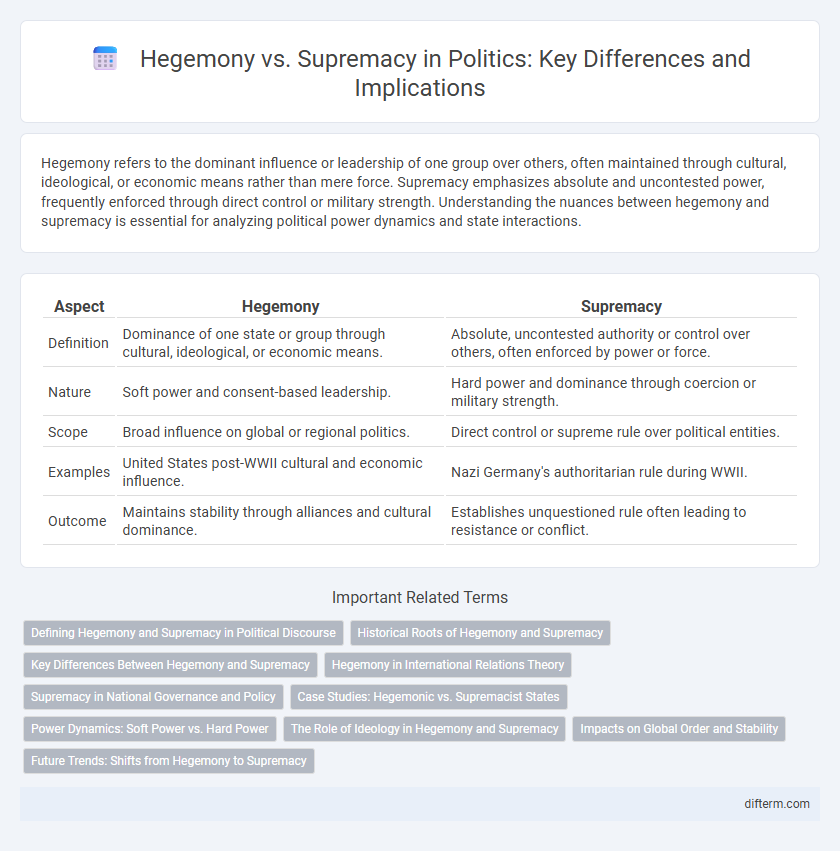Hegemony refers to the dominant influence or leadership of one group over others, often maintained through cultural, ideological, or economic means rather than mere force. Supremacy emphasizes absolute and uncontested power, frequently enforced through direct control or military strength. Understanding the nuances between hegemony and supremacy is essential for analyzing political power dynamics and state interactions.
Table of Comparison
| Aspect | Hegemony | Supremacy |
|---|---|---|
| Definition | Dominance of one state or group through cultural, ideological, or economic means. | Absolute, uncontested authority or control over others, often enforced by power or force. |
| Nature | Soft power and consent-based leadership. | Hard power and dominance through coercion or military strength. |
| Scope | Broad influence on global or regional politics. | Direct control or supreme rule over political entities. |
| Examples | United States post-WWII cultural and economic influence. | Nazi Germany's authoritarian rule during WWII. |
| Outcome | Maintains stability through alliances and cultural dominance. | Establishes unquestioned rule often leading to resistance or conflict. |
Defining Hegemony and Supremacy in Political Discourse
Hegemony in political discourse refers to the dominance of one state or group over others through cultural, ideological, or economic influence rather than direct coercion. Supremacy denotes absolute control or sovereignty, often enforced through military or legal authority with minimal opposition. Understanding the distinction highlights how hegemonic powers shape global norms indirectly, while supremacy emphasizes overt and uncontested dominance.
Historical Roots of Hegemony and Supremacy
Hegemony traces its historical roots to ancient Greece, where dominant city-states exerted cultural and political influence over others without direct control, emphasizing consent and ideological leadership. Supremacy, by contrast, emerged from colonial and imperial histories, characterized by explicit dominance, legal authority, and often racial or ethnic hierarchy imposed through force or coercion. The evolution of these concepts reflects differing approaches to power: consensual leadership in hegemony versus hierarchical domination in supremacy.
Key Differences Between Hegemony and Supremacy
Hegemony refers to the predominant influence or leadership of one state or group over others, often maintained through ideological dominance and consent rather than direct coercion. Supremacy implies absolute control or dominance, frequently enforced through power, authority, or militaristic strength. The key difference lies in hegemony's reliance on cultural and political persuasion, whereas supremacy is characterized by unchallenged, often authoritarian power.
Hegemony in International Relations Theory
Hegemony in International Relations Theory refers to the dominance of one state or group of states over others, shaping global norms, rules, and institutions primarily through consent and leadership rather than coercive force. This concept contrasts with supremacy, which implies absolute and often imposed control without the necessity of legitimacy or acceptance from subordinate states. Hegemonic powers, such as the United States in the post-World War II era, exercise influence by stabilizing the international order and promoting cooperation among states within a framework of shared interests.
Supremacy in National Governance and Policy
Supremacy in national governance asserts the ultimate authority of a state's constitution or central government over subordinate laws, ensuring unified policy implementation across all jurisdictions. This principle safeguards the consistency and legitimacy of national policies, preventing regional dissent from undermining central decisions. By prioritizing supremacy, governments can enforce regulations effectively, maintain order, and promote equitable development throughout the nation.
Case Studies: Hegemonic vs. Supremacist States
Hegemonic states, such as the United States during the post-Cold War era, maintain influence through economic power, diplomatic alliances, and cultural leadership, prioritizing global stability and multilateral cooperation. In contrast, supremacist states, exemplified by Nazi Germany, pursue dominance through ideology-driven expansionism, militarization, and racial or ethnic hierarchy enforcement, often resulting in conflict and oppression. Case studies reveal hegemonic states leverage soft power mechanisms, while supremacist states rely on coercive force to assert control over regional and international systems.
Power Dynamics: Soft Power vs. Hard Power
Hegemony in politics often involves soft power strategies, leveraging cultural influence, diplomacy, and economic incentives to shape the preferences and behaviors of other states. Supremacy, by contrast, centers on hard power, utilizing military dominance and coercive force to assert control and dictate terms. Understanding the interplay between soft power and hard power reveals how states maintain their positions within the international hierarchy and manage power dynamics globally.
The Role of Ideology in Hegemony and Supremacy
Ideology shapes hegemony by legitimizing dominant social groups through consent and cultural norms, embedding power within societal institutions. Supremacy relies on ideology to enforce dominance by asserting inherent superiority, often justifying exclusion or oppression. Both concepts use ideological frameworks, but hegemony operates through implicit acceptance, whereas supremacy demands explicit affirmation of control.
Impacts on Global Order and Stability
Hegemony shapes the global order through dominant influence exercised by a leading state, promoting relative stability by maintaining accepted norms and institutions. In contrast, supremacy entails absolute dominance, often provoking resistance and instability as other states challenge the imbalance of power. The dynamic tension between hegemony and supremacy significantly impacts international cooperation, conflict likelihood, and the overall stability of the global system.
Future Trends: Shifts from Hegemony to Supremacy
Emerging global power dynamics indicate a gradual shift from traditional hegemony, characterized by dominant influence through economic and cultural leadership, toward supremacy, marked by unequivocal control and military dominance. Future trends suggest that technological advancements in cyber warfare and artificial intelligence will accelerate this transition, as states prioritize absolute security over cooperative leadership. This shift challenges existing international norms, potentially leading to increased geopolitical instability and redefined alliances.
hegemony vs supremacy Infographic

 difterm.com
difterm.com